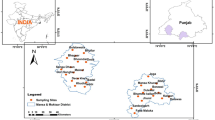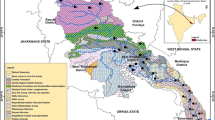Abstract
The present study was conducted to investigate trace metal (Li, Be, B, Al, Cr, Mn, Fe, Co, Ni, Cu, Zn, As Se, Mo, Cd, Sb, Ba and Pb) concentrations of drinking water samples in northeast Rajasthan, India. Furthermore, the study aimed to ascertain carcinogenic and non-carcinogenic health risks of metals by ingestion and dermal absorption pathways to the local residents. Metal concentrations were analyzed by using high resolution inductively coupled plasma mass spectrometry and compared with permissible limits set by the Bureau of Indian Standards, United States Environmental Protection Agency and World Health Organization. The results indicate that the concentrations of Be, B, Al, Cr, Fe, Cu, Zn, As, Mo, Sb and Ba were lower than their respective permissible limits, whereas the concentrations of Mn, Ni, Se, Cd and Pb in some samples were higher than their permissible limits.The total hazard index (summing the hazard index through ingestion and dermal routes) at all the sampling sites exceeded or nearing unity, indicating the presence of non-carcinogenic health effects from ingestion of water and dermal contact with water. The results indicate that the total excess lifetime cancer risk (considering both ingestion and dermal exposure pathways) of metals exposure was in accordance to the acceptable lifetime risks for carcinogens in drinking water (10-6–10-4). Both carcinogenic and non-carcinogenic risks were mainly attributed to the ingestion pathways.
Similar content being viewed by others
References
Agency for Toxic Substances and Disease Registry (ATSDR) (2012) Toxicological Profile for Cadmium, Atlanta, GA: U.S. Department of Public Health and Human Services, Public Health Service.
Agency for Toxic Substances and Disease Registry (ATSDR) (2005) Toxicological Profile for Nickel, Atlanta, GA: U.S. Department of Public Health and Human Services, Public Health Service.
BIS, IS: 10500(1993) Standards for Drinking water, Bureau of Indian Standards, New Delhi.
BIS (2012) Drinking Water–Specification, Second Revision, Bureau of Indian Standards, New Delhi.
Donaldson, S.G., Van Oostdam, J., Tikhonov, C., Feeley, M., Armsstrong, B., Ayotte, P., Boucher, O., Bowers, W., Chan, L., Dallaire, F., Dallaire, R., Dewailly, É., Edwards, J., Egeland, G.M., Fontaine, J., Furgal, C., Leech, T., Loring, E., Muckle, G., Nancarrow, T., Pereg, D., Plusquellec, P., Potyrala, M., Receveur, O. and Shearer, R.G. (2010) Environmental contaminants and human health in the Canadian Arctic. Sci. Total Environ., v.408, pp.5165–5234.
Duggal, V., Mehra, R. and Rani, A. (2013) Determination of 222RN level in groundwater using a RAD7 detector in the Bathinda district of Punjab, India. Radiat. Prot. Dosim., v.156, pp.239–245.
Frisbie, S.H., Ortega, R., Maynard, D.M. and Sarkar, B. (2002) The concentrations of arsenic and other toxic elements in Bangladesh’s drinking water. Environ. Health Prespect., v.110, pp.1147–1153.
Giri, S., Mahato, M.K., Singh, G. and Jha, V.N. (2012) Risk assessment due to intake of heavy metals through the ingestion of groundwater around two proposed uranium mining areas in Jharkhand, India. Environ. Monit. Assess., v.184, pp.1351–1358.
Harries, S., and Harper, B. (2004) Exposure Scenario for CTUIR traditional Subsistence Lifeways, Confederated Tribes of the Umatilla Indian Reservation, Department of Science and Engineering, Pendleton, Oregon.
Iqbal, J., Shah, M.H. and Akhter, G. (2013) Characterization, source apportionment and health risk assessment of trace metals in freshwater Rawal Lake, Pakistan. Jour. Geochem. Explor., v.125, pp.94–101.
Islam, Md.S., Ahmed, Md.K., Raknuzzaman, M., Habibullah-Al-Mamun, Md. and Islam, M.K. (2015) Heavy metal pollution in surface water and sediment: A preliminary assessment of an urban river in a developing country. Ecol. Indic., v.48, pp.282–291.
Krishna, A.K., Satyanarayanan, M. and Govil, P.K. (2009) Assessment of heavy metal pollution in water using multivariate statistical techniques in an industrial area: a case study from Patancheru, Medak District, Andhra Pradesh, India. Jour. Hazard. Material, v.167, pp.366–373.
Kumar, A., Vij, R., Gupta, M., Sharma, S. and Singh, S. (2015) Risk assessment of exposure to radon concentration and heavy metal analysis in drinking water samples in some areas of Jammu & Kashmir, India. Jour. Radioanal. Nucl. Chem., v.304, pp.1009–1016.
Kumar, T.B.P., Tiwary, A. and Fahmi, S. (2009) Nature of uranium mineralization in the Kerpura-Tiwari-ka-Bas Area, Sikar district, Rajasthan. Jour. Geol. Soc. India, v.73, pp.220–228.
Li, S. and Zhang, Q. (2010) Risk assessment and seasonal variations of dissolved trace elements and heavy metals in the Upper Han River, China. Jour. Hazard. Material, v.181, pp.1051–1058.
Miguel, E.De., Iribarren, I., Chacon, E., Ordonez, A. and Charlesworth, S. (2007) Risk-Based evaluation of the exposure of children to trace elements in playgrounds in Madrid (Spain). Chemosphere, v.66, pp.505–513.
Muhammad, S., Tahir Shah, M. and Khan, S. (2011) Health risk assessment of heavy metals and their source apportionment in drinking water of Kohistan region, northern Pakistan. Microchem. Jour., v.98, pp.334–343.
Ni, T., Diao, W., Xu, J. and Liu, N. (2011) Non-carcinogenic risk assessment of eight metals in the sourcegroundwater of Shaying River Basin. Ecotoxicology, v.20, pp.1117–1123.
Rani, A., Mehra, R., Duggal, V. and Balaram, V. (2013) Analysis of uranium concentration in drinking water samples using ICPMS. Health Phys., v.104, pp.251–255.
Rodell, M., Velicogna, I. and Famiglietti, J.S. (2009) Satellite-based estimates of groundwater depletion in India. Nature, v.460, pp.999–1002.
Rodriguez-Proteau, R. and Grant, R.L. (2005) Toxicity evaluation and human health risk assessment of surface and ground water contaminated by recycled hazardous waste materials. Handbook Environ. Chem., v.2, pp.133–189.
Sridhar, R., Thangaradjou, T., Sentnil, S.K. and Kannan L. (2006) Water quality and phytoplankton characteristics in the Palk Bay, Southeast coast of India. Jour. Environ. Biol., v.27, pp.561–566.
USDOE (2011) The Risk Assessment Information System (RAIS), U.S. Department of Energy’s Oak Ridge Operations Office (ORO), Washington, DC, USA.
US EPA (1989) Risk Assessment Guidance for Superfund Volume I: Human Health Evaluation Manual (Part A) Interim Final. EPA/540/1-89/002. U.S. Environmental Protection Agency, Office of Emergency and Remedial Response, Washington, DC, USA.
US EPA (1996) Quantitative Uncertainty Analysis of Superfund Residential Risk Pathway Models for Soil and Groundwater: White Paper. Office of Health and Environmental Assessment, Oak Ridge, TN, USA.
US EPA (1997) Exposure factors handbook. Office of research and development. EPA/600/P-95/002Fa. U.S. Environmental Protection Agency, Washington, DC.
US EPA (2001) Risk Assessment Guidance for Superfund: Volume III: Part A, process for conducting probabilistic risk assessment. EPA 540-R-02-002. Office of Emergency and Remedial Response. U.S. Environmental Protection Agency, Washington, DC.
US EPA (2004) Risk Assessment Guidance for Superfund Volume 1: Human health Evaluation Manual (Part E, Supplemental Guidance for Dermal Risk Assessment) Final. EPA/540/R/99/005 OSWER 9285.7-02EP PB99-963312 July 2004, Office of Superfund Remediation and Technology Innovation U.S. Environmental Protection Agency Washington, DC.
US EPA (2011) Edition of the Drinking Water Standards and Health Advisories, EPA 820-R-11-002, Office of Water, U.S. Environmental Protection AgencyWashington, DC.
WHO (1996) Guidelines for Drinking-water Quality, vol. 2, Health Criteria and Other Supporting Information, Second ed., Geneva, Switzerland.
WHO (2004) Guidelines for Drinking-water Quality, Third ed., Recommendations, vol.1, World Health Organization, Geneva, Switzerland.
WHO (2008) Guidelines for Drinking-water Quality, Third ed., Incorporating the first and second addenda, Recommendations, vol.1, World Health Organization, Geneva, Switzerland.
WHO (2011) Guidelines for Drinking-water Quality, Fourth ed., Recommendations, vol.1, World Health Organization, Geneva, Switzerland.
Wu, B., Zhao, D., Jia, H., Zhang, Y., Zhang, X. and Cheng, S. (2009) Preliminary risk assessment of trace metal pollution in surface water from Yangtze River in Nanjing Section, China. Bull. Environ. Contam. Toxicol. v.82, pp.405–409.
Author information
Authors and Affiliations
Corresponding author
Rights and permissions
About this article
Cite this article
Duggal, V., Rani, A., Mehra, R. et al. Risk assessment of metals from groundwater in northeast Rajasthan. J Geol Soc India 90, 77–84 (2017). https://doi.org/10.1007/s12594-017-0666-z
Received:
Revised:
Published:
Issue Date:
DOI: https://doi.org/10.1007/s12594-017-0666-z




